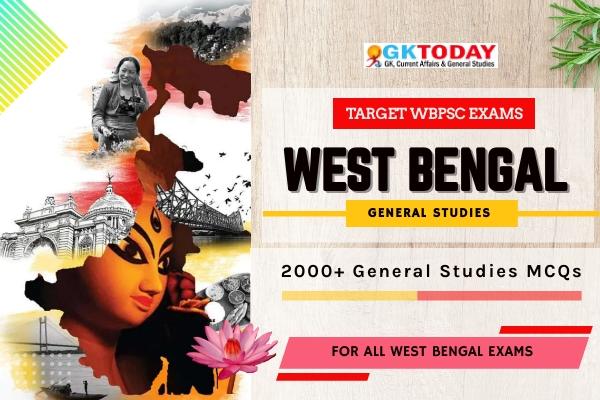States PCS: West Bengal GK Questions for WBPSC Examinations
For all West Bengal Public Service Commission (WBPSC) exams including WBCS, JE, AE, and other state-level competitive examinations.
1. Consider the following pairs of puppetry arts with states where they are practised:
- Kundhei – Odisha
- Gombeyatta – Karnataka
- Putul Nautch – West Bengal
Which of the above is/are correct?
[A] 1 & 2 Only
[B] 3 Only
[C] 2 & 3 Only
[D] 1, 2 & 3
Show Answer
Correct Answer: D [1, 2 & 3]
Notes:
The string puppets of Orissa are known as Kundhei. Made of light wood, the Orissa puppets have no legs but wear long flowing skirts. The traditional rod puppet form of West Bengal is known as Putul Nautch. They are carved from wood and follow the various artistic styles of a particular region. The string puppets of Karnataka are called Gombeyatta.
2. Consider the following pairs of Indian Handicrafts with their associated states:
- Channapatna Toys – Karnataka
- Pembarthi Metal Craft – Telangana
- Dhaniakhali Saree – West Bengal
Which of the above is/are correct?
[A] 1 & 2 Only
[B] 2 Only
[C] 1, 2 & 3
[D] None
Show Answer
Correct Answer: C [1, 2 & 3]
Notes:
Channapatna toys are a particular form of wooden toys (and dolls) that are manufactured in Channapatna in Bangalore, Karnataka. Pembarthi Metal Crafts are popular for their exquisite sheet metal art works. They are made in Pembarthi in Warangal district of Telangana. Dhaniakhali Saree is cotton Saree made in Dhaniakhali, West Bengal.
3. Consider the following pairs of Buddhist monasteries with states where they are located:
- Namgyal – Himachal Pradesh
- Shashur – Maharashtra
- Ghum – West Bengal
Which of the above is/are correct?
[A] 1 & 3 Only
[B] 3 Only
[C] 2 & 3 Only
[D] 1, 2 & 3
Show Answer
Correct Answer: A [ 1 & 3 Only]
Notes:
The Namgyal Monastery is located in the Dharamshala district of Himachal Pradesh. The Buddhist monastery Shashur is located in the Lahaul valley of Spiti in Himachal Pradesh. The Ghum Monastery is situated at the hill regions of Eastern Himalaya range in Darjeeling, West Bengal.
4. Which among the following pairs are correct?
- Cherry Blossoms- Karnataka
- Bordoisila- Assam
- Norwester- West Bengal
- Andhi- Rajasthan
Choose the correct option from the codes given below:
[A] 1 & 2
[B] 2 & 4
[C] 1, 2 & 4
[D] 1, 2, 3 & 4
Show Answer
Correct Answer: D [1, 2, 3 & 4]
Notes:
Cherry Blossoms- Karnataka. Bordoisila- Assam. Norwester- West Bengal. Andhi- Rajasthan.
5. Which one is not an example of lower Palaeolithic sites found in Bengal?
[A] Jagannathpuri
[B] Patina
[C] Paruldanga
[D] Satbati
Show Answer
Correct Answer: C [Paruldanga]
Notes:
Some important lower Palaeolithic sites are Egara Mail (Burdwan),
Parihati, Mohanpur, Satbati, Tarapheni reservoir bridge (all in Midnapore),
Nakbindhi, Patina, Jibdharipur (Birbhum), Jagannathpuri, etc.
6. Where is the ruins of Shashanka’s Karnasuvarna found in Bengal?
[A] Burdwan
[B] Rajbaridanga
[C] Padma
[D] Midnapore
Show Answer
Correct Answer: B [Rajbaridanga]
Notes:
Shashanka, the powerful ruler of Guada, had his capital at Karnasuvarna, the ruins of which have been discovered recently at Rajbaridanga (near the modern railway station Chiruti), six miles southwest of Behrampur, headquarters of Murshidabad district.
7. How many Pala kings ruled over the dynasty over years?
[A] 15
[B] 28
[C] 20
[D] 24
Show Answer
Correct Answer: C [20]
Notes:
The Pala dynasty ruled the regions of Bengal and Bihar for about 400 years, from the 8th century until the end of the 11th century, with about 20 leaders on the throne during the period.
8. Which one of these were the Sena kings?
[A] Kshatriyas
[B] Brahmanas
[C] Brahma-Kshatriyas
[D] Vaishyas
Show Answer
Correct Answer: C [Brahma-Kshatriyas]
Notes:
The Senas originally belonged to the Karnata country (Karnatadeshatagata) in South India, the Kanarese speaking region in modern Mysore, Karnataka and Andhra Pradesh of India, and they were Brahma-Ksatriyas (those who were Brahmanas first and became Ksatriyas afterwards).
9. Which is not the area that Trailokyachandra spread his reign over?
[A] Chandradvipa
[B] Vanga
[C] Assam
[D] Mithila
Show Answer
Correct Answer: D [Mithila]
Notes:
Trailokyachandra established their sovereign rule in Samatata area with Devaparvata as their centre of power and gradually spread it over Chandradvipa and parts of Vanga, and Assam.
10. How many administrative divisions was made by Nasiruddin in Bengal?
[A] 5
[B] 7
[C] 3
[D] 4
Show Answer
Correct Answer: C [3]
Notes:
After annexing Bengal in 1324, CE Tughlaq placed
Nasiruddin on the throne of Bengal. He attempted to ensure the loyalty of Bengal by dividing it into three administrative divisions with capitals at North Bengal, East Bengal and South Bengal; but his measures failed.

